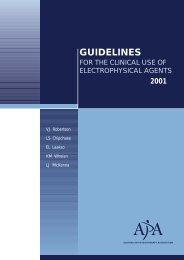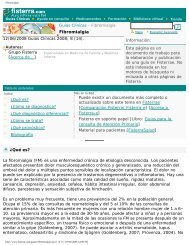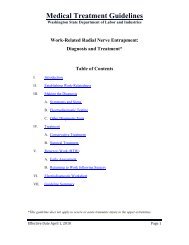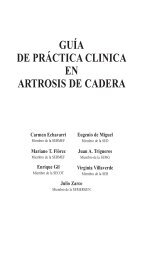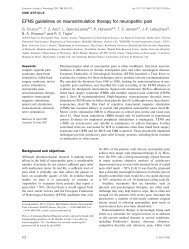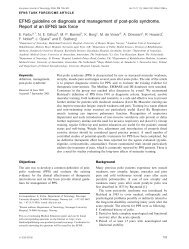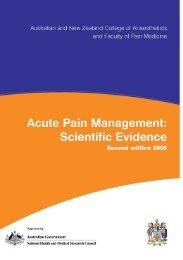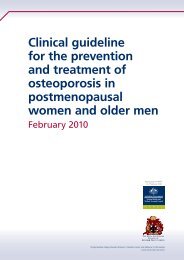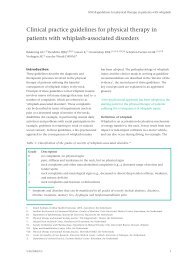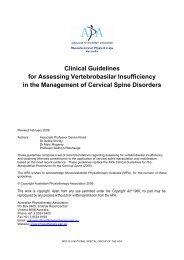Therapy Management of Congenital Muscular Torticollis
Therapy Management of Congenital Muscular Torticollis
Therapy Management of Congenital Muscular Torticollis
You also want an ePaper? Increase the reach of your titles
YUMPU automatically turns print PDFs into web optimized ePapers that Google loves.
Evidence-Based Care Guideline for <strong>Management</strong> <strong>of</strong> Clinical <strong>Muscular</strong> <strong>Torticollis</strong> in children age 0 to 36 months Guideline 33and one study reports that 20% <strong>of</strong> infants referred forevaluation <strong>of</strong> DP also had torticollis (Cheng 1994 [D]). DP,also referred to as posterior positional plagiocephaly orplagiocephaly without stenosis, describes an asymmetry<strong>of</strong> the infant skull or face not resulting from stenosis orpremature closure <strong>of</strong> the cranial sutures. Physicaltherapy interventions for CMT may also improvepositional preference and DP (van Vlimmeren 2008 [A], Freed2004 [S]).Up until the mid 1960’s, the standard treatment for CMTwas surgical release <strong>of</strong> the sternocleidomastoid muscle(SCM) during the first few months <strong>of</strong> life and wasfollowed by a lengthy period <strong>of</strong> immobilization in anovercorrected position. Over the next 25 years clinicalstudies revealed that good outcomes could be achievedfor CMT when treated conservatively with physicaltherapy and without surgery.In 1992 the American Academy <strong>of</strong> Pediatrics formallyintroduced the recommendation that all infants bepositioned in supine for sleeping with a “Back to Sleep”campaign (AAP 1992 [E]). The following decade saw adramatic increase, indeed an “epidemic” (de Chalain 2005[D]) in the number <strong>of</strong> infants referred to physical therapyfor treatment <strong>of</strong> CMT and the associated DP (Freed 2004[S]).The objectives <strong>of</strong> this guideline are to: promote appropriate referrals provide optimal skilled care to patients decrease unwarranted variation in care improve functional outcomes improve patient/family satisfactionInterventionNo higher-level evidence was identified, although abody <strong>of</strong> moderately strong evidence supports theeffectiveness <strong>of</strong> conservative treatment <strong>of</strong> CMT (Cheng2000 [C], Emery 1994 [D], Binder 1987 [D]).Over 90% <strong>of</strong> children achieve a good to excellentoutcome with conservative treatment when therapy isinitiated during the first 12 months <strong>of</strong> life (Cheng 2000[C]). Children in the SCM tumor group, those with aninitial deficit in cervical rotation <strong>of</strong> >30º, and thosewho initiate therapy after 12 months are more likely torequire surgical intervention to attain a functional andcosmetically acceptable outcome (Cheng 2000 [C]).Conservative treatment for CMT includes physicaltherapy and physician observation. Physical therapyinterventions include positioning, environmentaladaptations, passive and active stretching <strong>of</strong> the tightSCM, strengthening <strong>of</strong> weak neck and trunk musclesand movement therapy (Cheng 2000 [C], Emery 1994 [D],Binder 1987 [D], Freed 2004 [S]). Cheng et al. advocates aprogram <strong>of</strong> manual stretching provided by physicaltherapists (Cheng 2001 [C], Cheng 2000 [C]). In addition, itis recommended that a therapist train the child’scaregiver to implement a consistent therapy programat home (Emery 1994 [D], Binder 1987 [D], Freed 2004 [S]).Investigating factors associated with length <strong>of</strong>treatment duration, Emery reported that whenphysical therapy was initiated before age 2 years, theaverage duration <strong>of</strong> treatment was 4.7 months (SD 5.6months), although the range varied widely, from 1 to36 months, among the 100 children that achievedresolution without surgery (Emery 1994 [D]).Note 1: Some children may not achieve optimaloutcome with conservative management and mayrequire surgical intervention to achieve optimalfunctional outcome (Cheng 2001 [C], Cheng 2000 [C]).Note 2: Recent reports describe the use <strong>of</strong>Botulinum Toxin for some children who do notrespond adequately to conservative treatment (Joyce2005 [D], Oleszek 2005 [D], Do 2006 [E]).Expected OutcomeThe majority (>90%) <strong>of</strong> infants and children diagnosedwith CMT achieve good to excellent outcome withconservative treatment (Cheng 2000 [C], Taylor 1997 [D]).Conservative treatment may include passive stretching,active movement, strengthening, and positioning (Freed2004 [S]).Guideline RecommendationsAssessment (see Algorithm 1)1. It is recommended that a Physical <strong>Therapy</strong>Examination be completed, including thecomponents named in the Table (Karmel-Ross 1997[E]).Copyright © 2009 Cincinnati Children's Hospital Medical Center; all rights reserved. Page 2
Evidence-Based Care Guideline for <strong>Management</strong> <strong>of</strong> Clinical <strong>Muscular</strong> <strong>Torticollis</strong> in children age 0 to 36 months Guideline 33Table: Physical <strong>Therapy</strong> Examination ComponentsHistoryParent Report <strong>of</strong> History birth/deliveryo length <strong>of</strong> infant at birtho presence <strong>of</strong> skull asymmetry atbirtho presence <strong>of</strong> facial asymmetry atbirthCurrent Health feeding positioning devices used<strong>Torticollis</strong>/Plagiocephaly onsetHistory changes in symptomsSystems ReviewVisual Function midline visual focus ocular alignmentHip Screen asymmetry hip clunk leg length discrepancyNeurological Screen predominant Asymmetrical TonicNeck Reflex (ATNR) abnormal muscle tone presence <strong>of</strong> sustained clonusPain Assessment appropriate pain scaleSkin Screen clinical appearance <strong>of</strong> neckClinical ObservationsPlagiocephaly/AnthropometricsRange <strong>of</strong> MotionPalpation (Karmel-Ross1997 [E]), (Kendall1993 [E])Physical Assessment resting posture motor development cranial shape type cervical upper and lower extremity SCM Trapezius Scalenes2. It is recommended that following the assessment, ifthe patient does not meet the inclusion criteria ormeets exclusion criteria for the CMT guideline, thatthe evaluating therapist immediately contact thereferring physician for further consultation regardingappropriate treatment or the need for further medicalevaluation (Ballock 1996 [D]).3. It is recommended that an immediaterecommendation for referral to the appropriatespecialist be made to the referring physician if visual dysfunction is observed (Ophthalmology)(Ballock 1996 [D]) hip screen is failed (Orthopaedics) (Cheng 2000 [C]) neurological screen is failed (Neurology) (Ballock1996 [D]) patient demonstrates Plagiocephaly Type Ithrough V (Plastic Surgery) (Argenta 2004 [E]) patient presents with boney end feel(Orthopaedics) (Ballock 1996 [D]) patient is 18 months or older at presentation (LocalConsensus [E]).Treatment Recommendations (seeAlgorithm 2)Initial Visit4. It is recommended that the treatment <strong>of</strong> CMT beginat the time <strong>of</strong> the initial therapy evaluation andinclude: Instruction in home program to include stretchingexercises and range <strong>of</strong> motion exercises (cervicallateral flexion and rotation) (Freed 2004 [S]) Education on basic pathology <strong>of</strong> CMT (LocalConsensus [E]) Education on environmental adaptations andappropriate positioning to reduce deformationalforces to face and skull (Freed 2004 [S])Second Visit5. It is recommended that the second visit occur within2 weeks <strong>of</strong> the initial examination (Local Consensus[E]).6. It is recommended that the second visit include thecomponents (Freed 2004 [S]): review <strong>of</strong> established home exercise program(parent demonstration) provision <strong>of</strong> parental instruction on combinationstretches, parent hold and strengthening activities re-check <strong>of</strong> cervical range <strong>of</strong> motion, skull/facialasymmetry and posture/positioning developmental screen screening <strong>of</strong> upper extremity and lower extremityrange <strong>of</strong> motionSubsequent Visits7. It is recommended that all subsequent visits include: reassessment <strong>of</strong> range <strong>of</strong> motion (ROM), strength,and developmental progression review <strong>of</strong> the Home Education Program (HEP) addition <strong>of</strong> exercises, developmental activities andenvironmental adaptations as appropriate(Local Consensus [E])Copyright © 2009 Cincinnati Children's Hospital Medical Center; all rights reserved. Page 3
Evidence-Based Care Guideline for <strong>Management</strong> <strong>of</strong> Clinical <strong>Muscular</strong> <strong>Torticollis</strong> in children age 0 to 36 months Guideline 33Frequency and Progression <strong>of</strong> Intervention8. It is recommended that children age 0 to 4 months atthe onset <strong>of</strong> treatment, be followed every other weekto monitor and modify the program as appropriate(Local Consensus [E]).9. It is recommended that children age 4 to 5 months atthe onset <strong>of</strong> treatment, be followed weekly tomonitor and to modify the program as appropriate.A higher frequency is recommended when the childenters treatment at this age, due to the child’sdevelopmental ability to add strengtheningcomponents.Home program to include: righting and equilibrium reactions <strong>of</strong> head andtrunk transitional movements and weight shifting upper extremity (UE) weight bearing concentric and eccentric strengthening <strong>of</strong> headand trunk muscles(Freed 2004 [S], Local Consensus [E]).Note: Children greater than 4 months <strong>of</strong> agewho demonstrate >10 º <strong>of</strong> head tilt after 2 to 3months <strong>of</strong> treatment, may be assessed for apotential trial <strong>of</strong> kinesiotaping (Local Consensus[E]) and/or an orthosis (i.e., collar for tubularorthosis for torticollis [TOT], or a s<strong>of</strong>t orthosis).(Cottrill-Mosterman 1987 [O], Karmel-Ross 2006 [E],Local Consensus [E]).10. It is recommended that children age 6 to 8 months atthe onset <strong>of</strong> treatment, be followed weekly tomonitor and to modify the home program asappropriate.Home program to include: righting and equilibrium reactions in sitting antigravity strengthening <strong>of</strong> neck and trunk(Freed 2004 [S], Local Consensus [E]).11. It is recommended that children age 9 to 12 monthsold at the onset <strong>of</strong> treatment, be followed weekly tomonitor and to modify the program as appropriate.Home program to include: age appropriate balance and developmentalactivities equilibrium reactions in quadruped(Freed 2004 [S], Local Consensus [E]).12. It is recommended that children age 12 to 18 monthsat the onset <strong>of</strong> treatment, be followed every 1 to 2weeks: if head tilt is >5° after child becomesindependently ambulatory communicate withthe primary care provider to recommendconsideration <strong>of</strong> additional followup byorthopaedics and ophthalmology(Local Consensus [E]).13. It is recommended that children age 18 to 36 monthsat the onset <strong>of</strong> treatment be followed every 1 to 2weeks while awaiting specialty consults: regardless <strong>of</strong> head tilt or range <strong>of</strong> motion,communicate with primary care provider torecommend consideration <strong>of</strong> additionalfollowup by orthopaedics and ophthalmology(Local Consensus [E]).14. It is recommended that the child with residuallimitations after 6 months <strong>of</strong> treatment be referred tothe primary care provider for consideration <strong>of</strong>additional followup:Note 1: Continue plan <strong>of</strong> care while awaitingspecialty consults (Local Consensus [E]).Note 2: Consider a limited trial <strong>of</strong> s<strong>of</strong>t tissuetechniques while awaiting specialty consults(Local Consensus [E]). Surgical consult for children with less than 75degrees <strong>of</strong> cervical rotation or persistence <strong>of</strong>palpable tumor (Cheng 2001 [C], Cheng 2000 [C]).Note: Cheng states that surgical intervention isindicated in the above circumstance (Cheng 2001[C]). Ophthalmology consult for children with residualhead tilt with adequate ROM and strength (LocalConsensus [E]).Discharge from <strong>Therapy</strong>15. It is recommended that a child be discharged fromtherapy when therapy goals have been achieved.Goals include: cervical range <strong>of</strong> motion within 5 degrees <strong>of</strong>normal limits for passive and active lateral flexionand rotation. symmetrical posture in all functional positions. head in midline during activity the majority <strong>of</strong> thetime. symmetrical gross motor skills.(Local Consensus [E])16. It is recommended that parents be instructed thatplateaus in active range <strong>of</strong> motion and /or atemporary decrease in midline head control mayoccur during times <strong>of</strong>: gross motor progression, such as attainment <strong>of</strong>independent ambulation growth spurt ear infection or other illnessCopyright © 2009 Cincinnati Children's Hospital Medical Center; all rights reserved. Page 4
Evidence-Based Care Guideline for <strong>Management</strong> <strong>of</strong> Clinical <strong>Muscular</strong> <strong>Torticollis</strong> in children age 0 to 36 months Guideline 33At discharge, parents are instructed to resume homeexercises during these instances. If the abovepersists for more than 10 to 14 days, a therapyreassessment may be indicated (Karmel-Ross 1997 [E]).17. It is recommended that after 12 months <strong>of</strong> treatment,the child is re-evaluated to assess progress towardgoals and to determine if there will be a continuedbenefit from further therapy services. The childmay require additional medical intervention toachieve a more functional outcome: communicate with primary care provider todetermine future plan <strong>of</strong> care.(Local Consensus [E]).Note 1: Additional patient factors may beconsidered when determining discharge.Note 2: Average duration <strong>of</strong> treatment isreported to be less than 6 months, ranging from1 to 36 months. Initial severity <strong>of</strong> the deficit incervical rotation, a greater head tilt, or presence<strong>of</strong> a mass predict that a longer treatmentduration may be required to achieve optimaloutcome (Emery 1994 [D]).Future Research Agenda1. Clinical trial evaluating the effectiveness <strong>of</strong> program<strong>of</strong> passive stretching compared to a program <strong>of</strong>active range <strong>of</strong> motion and positioning (withoutpassive stretching).2. Clinical trial to determine the frequency <strong>of</strong> therapyintervention that results in optimal outcome.3. Clinical trial that more accurately predict whichinfants will not achieve optimal outcomes withconservative care.4. Clinical trial evaluating the effectiveness <strong>of</strong> the TOTcollar.Copyright © 2009 Cincinnati Children's Hospital Medical Center; all rights reserved. Page 5
Evidence-Based Care Guideline for <strong>Management</strong> <strong>of</strong> Clinical <strong>Muscular</strong> <strong>Torticollis</strong> in children age 0 to 36 months Guideline 33Algorithm 1: CMT Patient EvaluationStartReferral received for childwith diagnosis <strong>of</strong> torticollisDoes child have suddenonset <strong>of</strong> torticollis?YesPhysical <strong>Therapy</strong> Examination:Evaluate: cervical passive/active range <strong>of</strong>motion, skull/facial asymmetry,posture/positioningScreen: development, UE/LE passive/activerange <strong>of</strong> motionChild not eligible for guidelineNoDemonstrates anabnormal visualscreen for age?YesRecommend referral to OphthalmologyNoDemonstrates afailed hip screen?YesRecommend referral to OrthopaedicsNoDemonstratesabnormal neuroscreen?YesRecommend referral to NeurologyNoDemonstratesTypes I-Vplagiocephaly?YesRecommend referral to PlagiocephalyClinic/Plastic Surgery (non-urgent if under5 months old; urgent if over 5 months old)Instruct on effects <strong>of</strong> positioning devicesand abnormal positioning on head shapeNoDemonstrates cervicallateral flexion and/orrotation limitation <strong>of</strong>greater than 5 °?YesNoDischarge from PT withrecommendations for specialty followupCopyright © 2009 Cincinnati Children's Hospital Medical Center; all rights reserved. Page 6
Evidence-Based Care Guideline for <strong>Management</strong> <strong>of</strong> Clinical <strong>Muscular</strong> <strong>Torticollis</strong> in children age 0 to 36 months Guideline 33Algorithm 1: CMT Patient Evaluation (continued)Demonstrates cervicallateral flexion &/orrotation limitation <strong>of</strong>greater than 5 °?YesInstruct on home range <strong>of</strong> motion and stretchingprogram (cervical lateral flexion and rotation)Educate on basic pathology <strong>of</strong> CMT, appropriateenvironmental adaptationsNoChild older than 18months at time <strong>of</strong>referral?YesNoProvide appropriate homerecommendations/instructionsand discharge from PTInitiate CMT TreatmentClinical GuidelinesRecommend referral toOrthopaedics and Ophthalmology,even with normal screens. Initiatetreatment, follow once every 1-2weeks while awaiting specialtyconsults.Copyright © 2009 Cincinnati Children's Hospital Medical Center; all rights reserved. Page 7
Evidence-Based Care Guideline for <strong>Management</strong> <strong>of</strong> Clinical <strong>Muscular</strong> <strong>Torticollis</strong> in children age 0 to 36 months Guideline 33Algorithm 2: CMT Patient TreatmentAlgorithm 2: CMT Patient TreatmentStart-2 nd visit within 2weeks <strong>of</strong> initialexamination for childrenassessed to have CMT (SMT,MT, POST)Physical <strong>Therapy</strong> Treatment:Review: Home Exercise Program (HEP)Provide instruction: combination stretch, parenthold, strengthening (head righting if over 4 months)Re-check cervical range <strong>of</strong> motion, skull/facialasymmetry, posture/positioningScreen: development, UE/LE ROMChild age 0-4months at the onset<strong>of</strong> treatment?YesFollow every other weekNoChild age 4-5months at the onset<strong>of</strong> treatment?YesFollow weeklyNoChild age 6-8months at the onset<strong>of</strong> treatment?YesFollow weeklyNoChild age 9-12months at the onset<strong>of</strong> treatment?NoNoChild age 12-18months at the onset<strong>of</strong> treatment?YesYesFollow weeklyFollow once every 1 to 2weeks until child is anindependent ambulator.Then recommend referralsto Orthopaedics andOphthalmology (even withnormal screens) if head tilt is> 5º.Every Session:Re-assess: ROM and developmentalprogressionAssess: strengthReview: HEPAdd: exercises, developmentalactivities and environmentaladaptations as appropriateRe-evaluate: frequencyDecrease frequency to every otherweek with: Good compliance with HEP Improving ROM Good developmental progressionIncrease frequency to 2x/week with: Poor compliance with HEP Family needs more hands–ontrainingCopyright © 2009 Cincinnati Children's Hospital Medical Center; all rights reserved. Page 8
Evidence-Based Care Guideline for <strong>Management</strong> <strong>of</strong> Clinical <strong>Muscular</strong> <strong>Torticollis</strong> in children age 0 to 36 months Guideline 33Algorithm 2: CMT Patient Treatment (continued)Child age 18-36months at theonset <strong>of</strong>treatment?Persistent lateral tilt <strong>of</strong> >10º after 2-3 months <strong>of</strong>therapy (other planes <strong>of</strong>motion may be WFL)?YesConsider trial <strong>of</strong> TOTcollar, a s<strong>of</strong>t orthosisand/or kinesiotaping.NoYesContinue established plan <strong>of</strong> care.Every SessionRe-assess: ROM, strength and developmental progressionReview: HEPAdd: exercises, developmental No activities and environmental adaptations asappropriateRe-evaluate: frequencyRecommend referrals toOrthopaedics and toOphthalmology even withnormal screens.Initiate treatment, followonce every 1-2 weeks whileawaiting specialty consults.Does child demonstrateC-spine ROM WFL;Noand may have remaininglateral head tilt <strong>of</strong>
Evidence-Based Care Guideline for <strong>Management</strong> <strong>of</strong> Clinical <strong>Muscular</strong> <strong>Torticollis</strong> in children age 0 to 36 months Guideline 33CCHMC Grading ScaleGuideline Development Team 2007 - 2009Meta-analysis orM O Other evidenceSystematic ReviewDivision <strong>of</strong> Occupational <strong>Therapy</strong> and Physical <strong>Therapy</strong>Randomized controlled Expert opinion orCarol Burch PT, DPT, Division <strong>of</strong> Occupational <strong>Therapy</strong> andAEtrial: large sampleconsensusPhysical <strong>Therapy</strong>Randomized controlled Basic LaboratoryBFKelly Dreyer OTR/L, Division <strong>of</strong> Occupational <strong>Therapy</strong> and Physicaltrial: small sampleResearch<strong>Therapy</strong>Prospective trial or largeCPam Hudson PT, Division <strong>of</strong> Occupational <strong>Therapy</strong> and Physicalcase seriesL Legal requirement<strong>Therapy</strong> D Retrospective analysis Q Decision analysisRebecca D. Reder OTD, OTR/L, Senior Clinical Director,Occupational <strong>Therapy</strong> and Physical <strong>Therapy</strong>M. Tatiana Ritchey PT, DPT, Division <strong>of</strong> Occupational <strong>Therapy</strong> andS Review article X No evidencePhysical <strong>Therapy</strong>Mariann L. Strenk PT, MHS, Division <strong>of</strong> Occupational <strong>Therapy</strong> andPhysical <strong>Therapy</strong>years, the development team reconvenes to explore the continuedvalidity <strong>of</strong> the guideline. This phase can be initiated at any point thatevidence indicates a critical change is needed.Molly Woosley PT, DPT, ATP, Division <strong>of</strong> Occupational <strong>Therapy</strong>and Physical <strong>Therapy</strong>Division <strong>of</strong> Health Policy & Clinical Effectiveness SupportKim Mason RN, MSN, PCNS-BC, Guidelines ProgramAdministratorEloise Clark MPH, MBA, Guidelines Program AdministratorBarbarie Hill MLS, Pratt LibraryAll Team Members and Clinical Effectiveness support staff listedabove have signed a conflict <strong>of</strong> interest declaration.Ad Hoc AdvisorStephen Pleatman, MD, Community PediatricianDevelopment ProcessThe process by which this guideline was developed is documented inthe Guideline Development Process Manual; a Team Bindermaintains minutes and other relevant development materials. Therecommendations contained in this guideline were formulated by aninterdisciplinary working group which performed systematic andcritical literature reviews, using the grading scale that follows, andexamined current local clinical practices.To select evidence for critical appraisal by the group for the update <strong>of</strong>this guideline, the Medline, EmBase and the Cochrane databases weresearched for dates <strong>of</strong> January 1965 to April 2008 to generate anunrefined, “combined evidence” database using a search strategyfocused on answering clinical questions relevant to congenitalmuscular torticollis and employing a combination <strong>of</strong> Booleansearching on human-indexed thesaurus terms (MeSH headings usingan OVID Medline interface) and “natural language” searching onsearching on human-indexed thesaurus terms (MeSH headings usingan OVID Medline interface) and “natural language” searching onwords in the title, abstract, and indexing terms. The citations werereduced by eliminating duplicates, review articles, non-Englisharticles, and adult articles. During the course <strong>of</strong> the guidelinedevelopment, additional clinical questions were generated andsubjected to the search process, and some relevant review articleswere identified.Tools to assist in the effective dissemination and implementation <strong>of</strong>the guideline may be available online athttp://www.cincinnatichildrens.org/svc/alpha/h/health-policy/evbased/default.htm. Once the guideline has been in place for threeRecommendations have been formulated by a consensus processdirected by best evidence, patient and family preference and clinicalexpertise. During formulation <strong>of</strong> these recommendations, the teammembers have remained cognizant <strong>of</strong> controversies anddisagreements over the management <strong>of</strong> these patients. They havetried to resolve controversial issues by consensus where possible and,when not possible, to <strong>of</strong>fer optional approaches to care in the form <strong>of</strong>information that includes best supporting evidence <strong>of</strong> efficacy foralternative choices.The guideline has been reviewed and approved by clinical experts notinvolved in the development process, distributed to seniormanagement <strong>of</strong> Cincinnati Children’s Hospital Medical Center(CCHMC), and other parties as appropriate to their intendedpurposes.The guideline was developed without external funding. All TeamMembers and Clinical Effectiveness support staff listed have declaredwhether they have any conflict <strong>of</strong> interest and none were identified.Copies <strong>of</strong> this Evidence-based Care Guideline (EBCG) and its anyavailable implementation tools are available online and may bedistributed by any organization for the global purpose <strong>of</strong> improvingchild health outcomes. Website address:http://www.cincinnatichildrens.org/svc/alpha/h/healthpolicy/ev-based/default.htmExamples <strong>of</strong> approved uses <strong>of</strong> theEBCG include the following:• copies may be provided to anyone involved in the organization’sprocess for developing and implementing evidence based careguidelines;• hyperlinks to the CCHMC website may be placed on theorganization’s website;• the EBCG may be adopted or adapted for use within theorganization, provided that CCHMC receives appropriateattribution on all written or electronic documents; and• copies may be provided to patients and the clinicians who managetheir care.Notification <strong>of</strong> CCHMC at HPCEInfo@cchmc.org for any EBCG,or its companion documents, adopted, adapted, implemented orhyperlinked by the organization is appreciated.NOTE: These recommendations result from review <strong>of</strong> literatureand practices current at the time <strong>of</strong> their formulations. Thisguideline does not preclude using care modalities provenefficacious in studies published subsequent to the current revision<strong>of</strong> this document. This document is not intended to imposestandards <strong>of</strong> care preventing selective variances from therecommendations to meet the specific and unique requirementsCopyright © 2009 Cincinnati Children's Hospital Medical Center; all rights reserved. Page 10
Evidence-Based Care Guideline for <strong>Management</strong> <strong>of</strong> Clinical <strong>Muscular</strong> <strong>Torticollis</strong> in children age 0 to 36 months Guideline 33<strong>of</strong> individual patients. Adherence to this guideline is voluntary.The physician in light <strong>of</strong> the individual circumstances presentedby the patient must make the ultimate judgment regarding thepriority <strong>of</strong> any specific procedure.For more information about this guideline, its supporting evidences andthe guideline development process, contact the Division <strong>of</strong> Occupational<strong>Therapy</strong> and Physical <strong>Therapy</strong> Office at 513-636-4651.Copyright © 2009 Cincinnati Children's Hospital Medical Center; all rights reserved. Page 11
http://www.ncbi.nlm.nih.gov/entrez/query.fcgi?cmd=Retrieve&db=PubMed&dopt=Citation&list_uids=16470158 Evidence-Based Care Guideline for <strong>Management</strong> <strong>of</strong> Clinical <strong>Muscular</strong> <strong>Torticollis</strong> in children age 0 to 36 months Guideline 33ReferencesNote: When using the electronic version <strong>of</strong> this document, “http://www.ncbi.nlm.nih.gov/eubMed&dopt=Citation&list_uids=3126646”refers to journal articles that have a hyperlink to the abstract. Ahyperlink following this symbol goes to the article PDF when the useris within the CCHMC network.1. AAP: American Academy <strong>of</strong> Pediatrics AAP Task Force onInfant Positioning and SIDS: Positioning and SIDS. Pediatrics,89(6 Pt 1): 1120-6, 1992, [E] http://www.ncbi.nlm.nih.gov/entrez/query.fcgi?cmd=Retrieve&db=PubMed&dopt=Citation&list_uids=1503575 http://Groups/p2/EBC_Files/Articles_Cited_in_<strong>Torticollis</strong>_Guideline/<strong>Torticollis</strong>AAP1992.pdf.2. Argenta, L.; David, L.; and Thompson, J.: Clinicalclassification <strong>of</strong> positional plagiocephaly. J Crani<strong>of</strong>ac Surg,15(3): 368-72, 2004, [E] http://www.ncbi.nlm.nih.gov/entrez/query.fcgi?cmd=Retrieve&db=PubMed&dopt=Citation&list_uids=15111792http://Groups/p2/EBC_Files/Articles_Cited_in_<strong>Torticollis</strong>_Guideline/<strong>Torticollis</strong>Argenta2004.pdf.3. Ballock, R. T., and Song, K. M.: The prevalence <strong>of</strong>nonmuscular causes <strong>of</strong> torticollis in children. J Pediatr Orthop,16(4): 500-4, 1996, [D] http://www.ncbi.nlm.nih.gov/entrez/query.fcgi?cmd=Retrieve&db=PubMed&dopt=Citation&list_uids=8784706http://Groups/p2/EBC_Files/Articles_Cited_in_<strong>Torticollis</strong>_Guideline/<strong>Torticollis</strong>Ballock1996.pdf.4. Binder, H.; Eng, G. D.; Gaiser, J. F.; and Koch, B.:<strong>Congenital</strong> muscular torticollis: results <strong>of</strong> conservativemanagement with long-term follow-up in 85 cases. Arch PhysMed Rehabil, 68(4): 222-5, 1987, [D] http://www.ncbi.nlm.nih.gov/entrez/query.fcgi?cmd=Retrieve&db=PubMed&dopt=Citation&list_uids=3566514 http://Groups/p2/EBC_Files/Articles_Cited_in_<strong>Torticollis</strong>_Guideline/<strong>Torticollis</strong>Binder1987.pdf.5. Cheng, J. C., and Au, A. W.: Infantile torticollis: a review <strong>of</strong>624 cases. J Pediatr Orthop, 14(6): 802-8, 1994, [D] http://www.ncbi.nlm.nih.gov/entrez/query.fcgi?cmd=Retrieve&db=PubMed&dopt=Citation&list_uids=7814599http://Groups/p2/EBC_Files/Articles_Cited_in_<strong>Torticollis</strong>_Guideline/<strong>Torticollis</strong>Cheng1994.pdf.6. Cheng, J. C.; Tang, S. P.; Chen, T. M.; Wong, M. W.; andWong, E. M.: The clinical presentation and outcome <strong>of</strong>treatment <strong>of</strong> congenital muscular torticollis in infants--a study <strong>of</strong>1,086 cases. J Pediatr Surg, 35(7): 1091-6, 2000, [C] http://www.ncbi.nlm.nih.gov/entrez/query.fcgi?cmd=Retrieve&db=PubMed&dopt=Citation&list_uids=10917303 http://Groups/p2/EBC_Files/Articles_Cited_in_<strong>Torticollis</strong>_Guideline/<strong>Torticollis</strong>Cheng2000.pdf.7. Cheng, J. C.; Wong, M. W.; Tang, S. P.; Chen, T. M.; Shum,S. L.; and Wong, E. M.: Clinical determinants <strong>of</strong> the outcome<strong>of</strong> manual stretching in the treatment <strong>of</strong> congenital musculartorticollis in infants. A prospective study <strong>of</strong> eight hundred andtwenty-one cases. J Bone Joint Surg Am, 83-A(5): 679-87, 2001,[C] http://www.ncbi.nlm.nih.gov/entrez/query.fcgi?cmd=Retrieve&db=PubMed&dopt=Citation&list_uids=11379737http://Groups/p2/EBC_Files/Articles_Cited_in_<strong>Torticollis</strong>_Guideline/<strong>Torticollis</strong>Cheng2001.pdf.8. Cooperman, D.: The differential diagnosis <strong>of</strong> torticollis inchildren. Phys Occ Ther Pediatr, 17(2): 1-11, 1997, [S] http://groups/p2/EBC_Files/Articles_Cited_in_<strong>Torticollis</strong>_Guideline\<strong>Torticollis</strong>Cooperman1997.pdf.14. Joyce, M. B., and de Chalain, T. M.: Treatment <strong>of</strong> recalcitrantidiopathic muscular torticollis in infants with botulinum toxintype a. J Crani<strong>of</strong>ac Surg, 16(2): 321-7, 2005, [D] http://www.ncbi.nlm.nih.gov/entrez/query.fcgi?cmd=Retrieve&db=PubMed&dopt=Citation&list_uids=15750434http://Groups/p2/EBC_Files/Articles_Cited_in_<strong>Torticollis</strong>_Guideline/<strong>Torticollis</strong>Joyce2005.pdf.15. Karmel-Ross, K.: <strong>Congenital</strong> <strong>Muscular</strong> <strong>Torticollis</strong>. In Physical<strong>Therapy</strong> for Children, pp. 359-380. Edited by Campbell, S., St.Louis, Saunders Elsevier, 2006, [E] http://Groups/p2/EBC_Files/Articles_Cited_in_<strong>Torticollis</strong>_Guideline/<strong>Torticollis</strong>KarmelRoss2006.pdf.16. Karmel-Ross, K., and Lepp, M.: Assessment and Treatment <strong>of</strong>Children with <strong>Congenital</strong> Muscualr Tortiocollis. Phys Occ TherPediatr, 17(2): 21-67, 1997, [E] .17. Kendall, F.; McCreary, E.; and Provance, P.: Muscle Testingand Function. 1993, [E] http://groups/p2/EBC_Files/Articles_Cited_in_<strong>Torticollis</strong>_Guideline/<strong>Torticollis</strong>Kendall1993.pdf.18. Local Consensus: During guideline development timeframe.[E] .19. Oleszek, J. L.; Chang, N.; Apkon, S. D.; and Wilson, P. E.:Botulinum toxin type a in the treatment <strong>of</strong> children withcongenital muscular torticollis. Am J Phys Med Rehabil, 84(10):813-6, 2005, [D] http://www.ncbi.nlm.nih.gov/entrez/query.fcgi?cmd=Retrieve&db=PubMed&dopt=Citation&list_uids=16205437http://Groups/p2/EBC_Files/Articles_Cited_in_<strong>Torticollis</strong>_Guideline/<strong>Torticollis</strong>Oleszek2005.pdf.20. Scoles, P.: Pediatric Orthopedics in Clinical Practice. 1988, [E] http://groups/p2/EBC_Files/Articles_Cited_in_<strong>Torticollis</strong>_Guideline/<strong>Torticollis</strong>Scoles1988.pdf.21. Stellwagen, L.: Look for the stuck baby to identify congenitaltorticollis. Contemporary Pediatrics, 21(5): 55-59, 2004, [S] http://Groups/p2/EBC_Files/Articles_Cited_in_<strong>Torticollis</strong>_Guideline/<strong>Torticollis</strong>Stellwagen2004.pdf.22. Taylor, J. L., and Norton, E. S.: Developmental <strong>Muscular</strong><strong>Torticollis</strong>: Outcomes in Young Children Treated by Physical<strong>Therapy</strong>. Pediatric Physical <strong>Therapy</strong>, 9: 173-178, 1997, [D] http://Groups/p2/EBC_Files/Articles_Cited_in_<strong>Torticollis</strong>_Guideline/<strong>Torticollis</strong>Taylor1997.pdf.23. van Vlimmeren, L. A.; van der Graaf, Y.; Boere-Boonekamp, M. M.; L'Hoir, M. P.; Helders, P. J.; andEngelbert, R. H.: Effect <strong>of</strong> pediatric physical therapy ondeformational plagiocephaly in children with positionalpreference: a randomized controlled trial. Arch Pediatr AdolescMed, 162(8): 712-8, 2008, [A] http://www.ncbi.nlm.nih.gov/entrez/query.fcgi?cmd=Retrieve&db=PubMed&dopt=Citation&list_uids=18678802 http://Groups/p2/EBC_Files/Articles_Cited_in_<strong>Torticollis</strong>_Guideline/<strong>Torticollis</strong>vanVlimmermen2008.pdf.9. Cottrill-Mosterman, S.; Jacques, C.; and Bartlett, D.:Orthotic Treatment <strong>of</strong> head tilt in Children with <strong>Congenital</strong><strong>Muscular</strong> <strong>Torticollis</strong>. J Assoc Children’s Prosthetic-OrthoticClinics, 22: 1-3, 1987, [O] http://www.acpoc.org/library/1987_01_001.asp http://Groups/p2/EBC_Files/Articles_Cited_in_<strong>Torticollis</strong>_Guideline/<strong>Torticollis</strong>Cottrill1987.pdf.10. de Chalain, T. M., and Park, S.: <strong>Torticollis</strong> associated withpositional plagiocephaly: a growing epidemic. J Crani<strong>of</strong>ac Surg,16(3): 411-8, 2005, [D] http://www.ncbi.nlm.nih.gov/entrez/query.fcgi?cmd=Retrieve&db=PubMed&dopt=Citation&list_uids=15915106 http://Groups/p2/EBC_Files/Articles_Cited_in_<strong>Torticollis</strong>_Guideline/<strong>Torticollis</strong>deChalain2005.pdf.11. Do, T. T.: <strong>Congenital</strong> muscular torticollis: current concepts andreview <strong>of</strong> treatment. Curr Opin Pediatr, 18(1): 26-9, 2006, [E]http://Groups/p2/EBC_Files/Articles_Cited_in_<strong>Torticollis</strong>_Guideline/<strong>Torticollis</strong>Do2006.pdf.12. Emery, C.: The determinants <strong>of</strong> treatment duration forcongenital muscular torticollis. Phys Ther, 74(10): 921-9, 1994,[D] http://www.ncbi.nlm.nih.gov/entrez/query.fcgi?cmd=Retrieve&db=PubMed&dopt=Citation&list_uids=8090843http://Groups/p2/EBC_Files/Articles_Cited_in_<strong>Torticollis</strong>_Guideline/<strong>Torticollis</strong>Emery1994.pdf.13. Freed, S.: Identification and treatment <strong>of</strong> congenital musculartorticollis in infants. Journal <strong>of</strong> Prosthetics and Orthotics,16(4s): 18, 2004, [S] http://Groups/p2/EBC_Files/Articles_Cited_in_<strong>Torticollis</strong>_Guideline/<strong>Torticollis</strong>Freed2004.pdf.Copyright © 2009 Cincinnati Children's Hospital Medical Center; all rights reserved. Page 12



